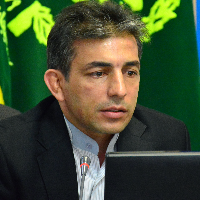Spatial and temporal study of areas vulnerable to hail on agricultural products of East Azerbaijan province
Hail is a natural disaster for all people, especially farmers. The Hail damage depends on the frequency and intensity of rainfall. Usually in the insurance industry to calculate the risk of hail damage in each area, the frequency of rainfall (in terms of days) and the average damage, which is statistically significant are used. Hail is one of the phenomena connected with thunderstorms that occur in unstable atmospheres with high humidity and in the presence of strong winds and with mechanisms that increase instability, and these conditions are affected by local topography and climatology of air masses. Therefore, according to the natural risk management strategy, which is a potential and very serious role in reducing the damage caused by natural disasters in the region, hail can be predicted and dealt with and led to control of the resulting damage. Therefore, in order to investigate the spatial and temporal distribution of hail damage on agricultural products of East Azerbaijan province, the zoning of vulnerable areas in terms of hail damage, the cause of possible differences in different areas and the conditions in which this rainfall is present, were examined.
East Azerbaijan is located in northwestern Iran between 36˚47' N and 39˚ 40' N latitudes and between 45˚ 3' E and 48˚ 50' E longitudes. East Azerbaijan with an area of 45261.4 square kilometers is located in the northwestern of the Iranian plateau. In this study, to investigate and analyze the losses of the agricultural sector due to hail, the data of the agricultural Insurance fund for the were useded from 2010-2019. In many cases the hail phenomenon occurs in small area where there are limited number of synoptic stations so the occurrence of this phenomenon cannot be seen and recorded. Therefore, in order to assess the damage caused by hail in the study area, the day's whit hail damages were extracted and examined from the data of the Agricultural Products Insurance Fund. Then, spatial statistics, hot spot index and ARC GIS software were used to identify areas vulnerable to hail.
The results showed that the damage caused by this phenomenon on Agricultural crops in East Azerbaijan province is an average of 123.5 hectares per year, Bonab with annual average 568.1 hectares and Ahar with 491.2 hectares and Tark with 476.2 hectares are in the next ranks. But in terms of damage to crops, it was determined that Qara Aghaj with an annual average of 1143.9 hectares has the highest level of damage and Hashtrood with 826.6 hectares and Ahar with 369.1 hectares are in the next ranks.In terms of the level of damage to the total crop and horticultural products during the study period, it was found that in the province, on average, about 262 hectares of the province's area under cultivation are damaged annually due to this phenomenon. The highest level of damage is related to Qara Aghaj region with an annual average of 1159.7 hectares, which includes 14.7% of the total hail damages in the study area, and Hashtrood and Ahar with 1057.9 (13.4%) and 860.3 hectares (10.9%, respectively). Are in the next ranks. The spatial statistics and spatial autocorrelation techniques were used identify areas vulnerable to hail, and the Gi* index was used to ensure areas with high and low value clusters. The results showed that in agriculture, the values of positive spatial correlation are concentrated in parts of the south of the province, which is the most vulnerable area, the central parts of Charavimaq and Shadian, In the garden sector, the values of positive spatial correlation are concentrated the northwest and southwest of the province, and among most vulnerable area in the study are in the central and Yamchi Marand districts.
The results of this study showed that the highest frequency of damaging hail occurred in May and the lowest frequency occurred in August. The results also showed that about 71% of the harmful hail in the study area occurred in the warm seasons, which coincides with the plant growing season in this area. In the period under review, the rainfall of harmful hail in East Azerbaijan province was on average between 09:00 and 15:00 (G.M.T) more than other hours, and in this 10-year period, the maximum rainfall occurred at 12:00.In the study of hot spots based on Gi* index, it was found that in agriculture, high values (positive spatial autocorrelation) are concentrated in parts of the south and northwest of the province, respectively. Examination of the total damage of agriculture and horticulture showed that high values (positive spatial correlation) are concentrated in parts of the south of the province, and the most vulnerable areas in the study are the central parts of Charavimaq, Shadian and Nazar Kahrizi. On the other hand, a region with less vulnerability in parts of the west of the province, especially the central parts of Osku, Khosrowshahr, Mamqan, Gogan and the suburbs of Azarshahr, corresponds to areas with a spatial distribution pattern with the highest significant negative spatial self-correlation and 99 Percentages (strong-cold-cold cluster) are concentrated. By examining vulnerable areas, we can point to the high area under cultivation in these areas, as well as the impact of local factors such as topography, altitude and external factors, such as the entry of hail storms from the west and southwest of the province in its occurrence and intensification. The results of this study show the efficiency of spatial statistics techniques in identifying vulnerable areas and proper segregation based on the principles of spatial statistics and can be used as a model in other agricultural and economic sectors of the country. It is also recommended to study this index and combine the information obtained from spatial statistics with climatic information, studying the long-term impact of phenomena on changes in the pattern of hot spots and developing other spatial indicators in future studies.
- حق عضویت دریافتی صرف حمایت از نشریات عضو و نگهداری، تکمیل و توسعه مگیران میشود.
- پرداخت حق اشتراک و دانلود مقالات اجازه بازنشر آن در سایر رسانههای چاپی و دیجیتال را به کاربر نمیدهد.




